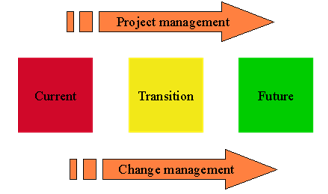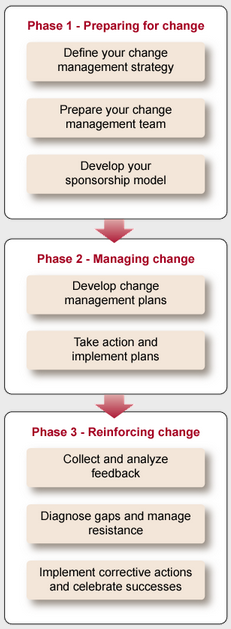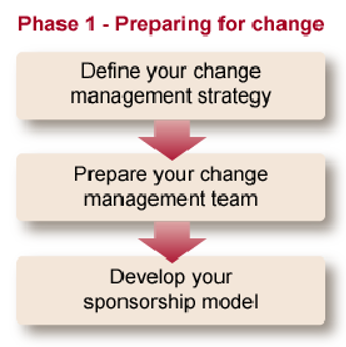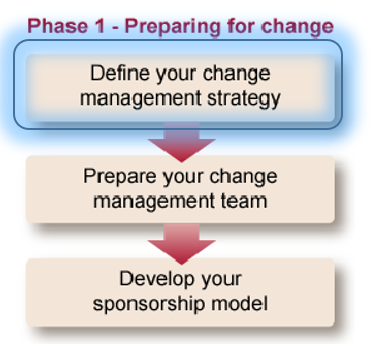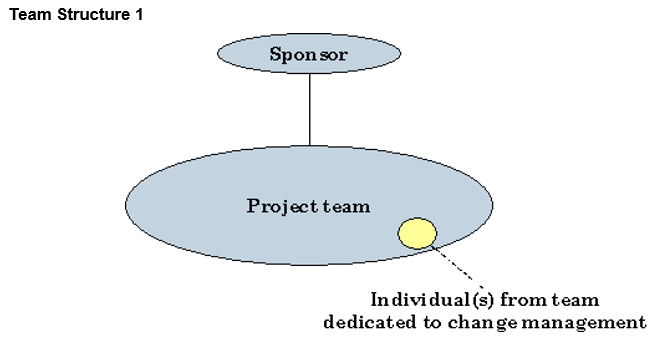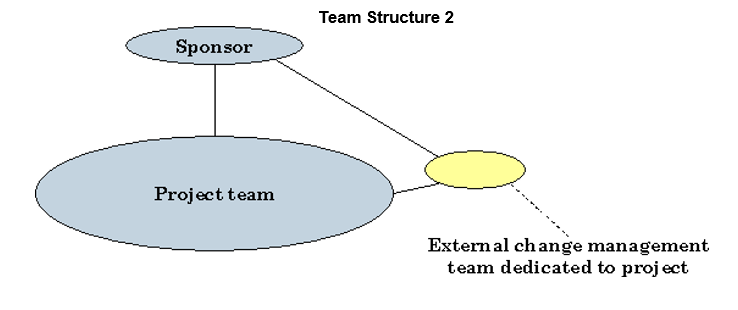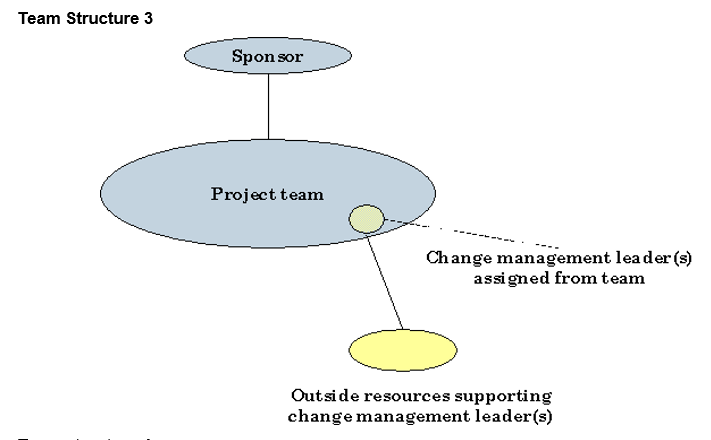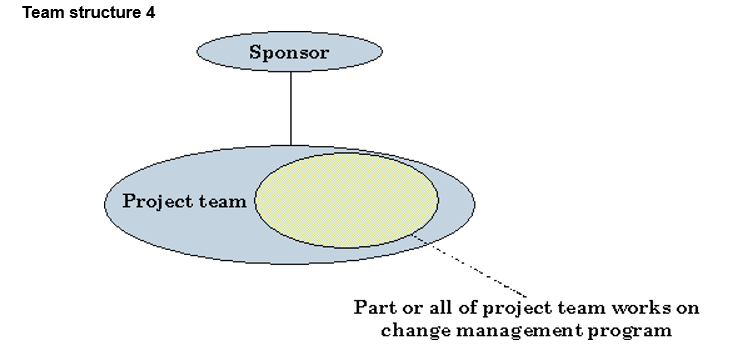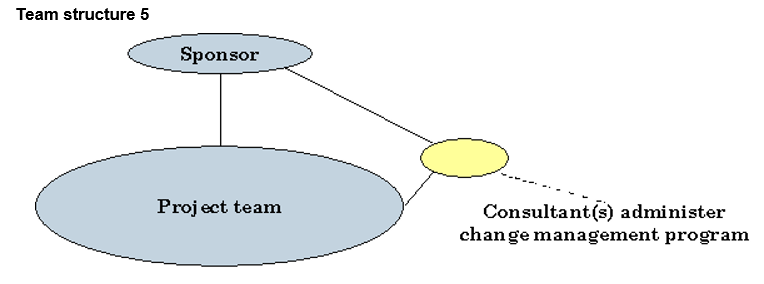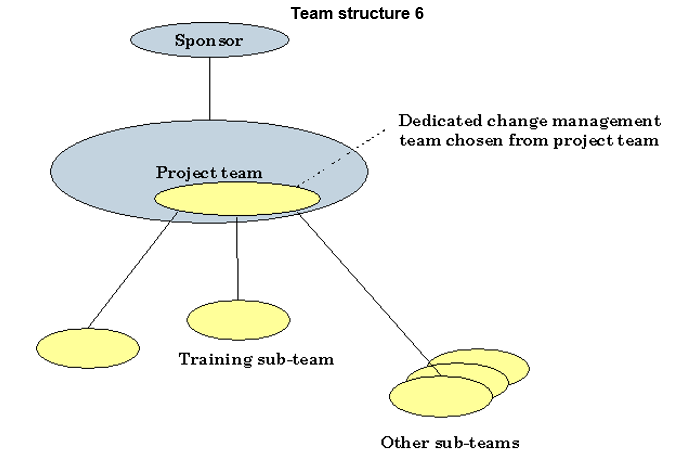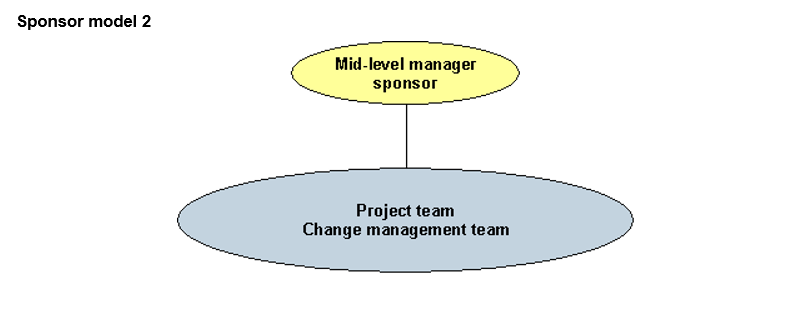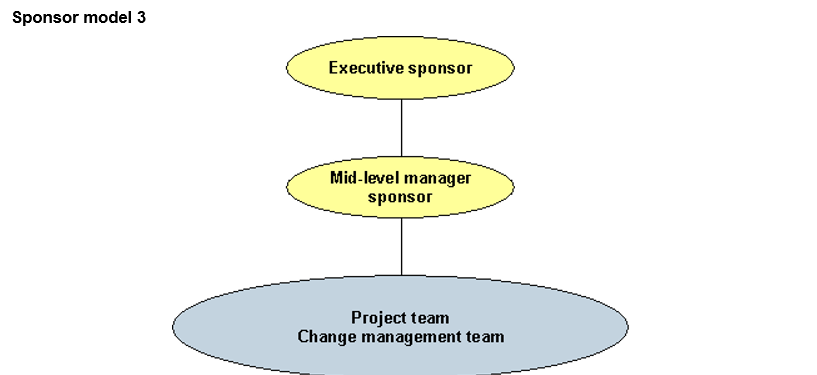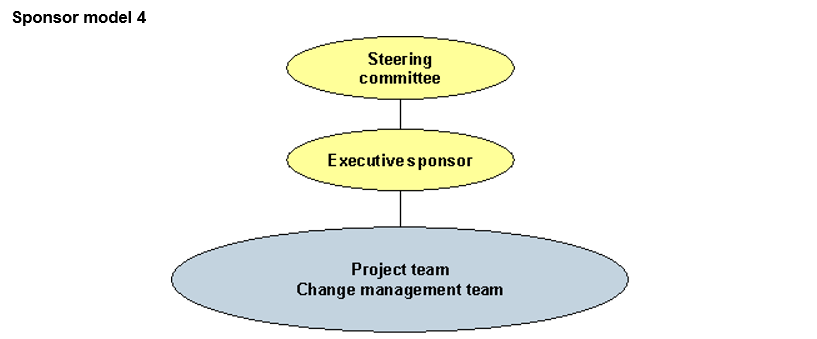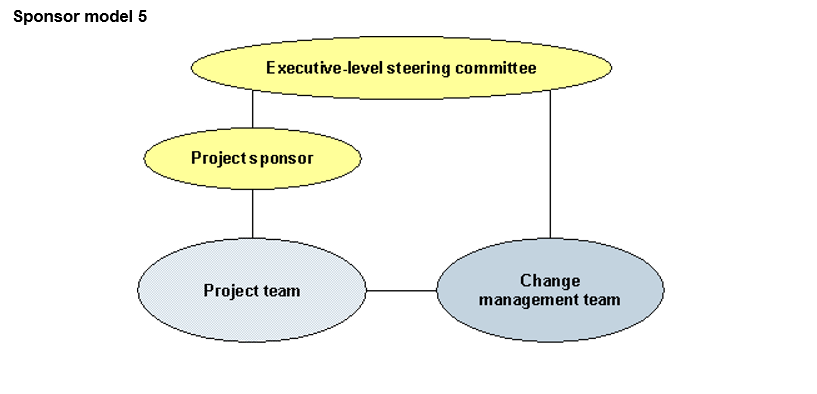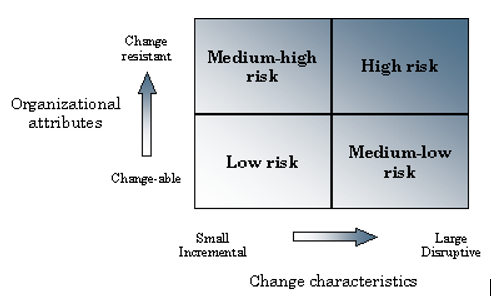Change Management
| Source: | DataSource |
|---|---|
| Language: | English |
| Topic: | Change Management |
| SubTopic: | ADKAR |
| Last Edit By: | DochyJP |
| LastEdit: | 2021-04-15 |
| Document type: | Training |
| Status: | Active |
| Access: | free |
Introduction
What is Change Management
Context and objectives
When introducing a change to the organization, we are ultimately going to be impacting one or more of the following four parts of how the organization operates:
- Processes
- Systems
- Organization structure
- Job roles
While there are numerous approaches and tools that can be used to improve the organization, all of them ultimately prescribe adjustments to one or more of the four parts of the organization listed above. Change typically results as a reaction to specific problems or opportunities the organization is facing based on internal or external stimuli. While the notion of 'becoming more competitive' or 'becoming closer to the customer' or 'becoming more efficient' can be the motivation to change, at some point these goals must be transformed into the specific impacts on processes, systems, organization structures or job roles. This is the process of defining 'the change'.
Ultimately, the goal of change is to improve the organization by altering how work is done.
Change Management vs Project Management
However, it is not enough to merely prescribe 'the change' and expect it to happen - creating change within an organization takes hard work and structure around what must actually take place to make the change happen. To begin, lets look at the formal definitions of project management and change management - two key disciplines required to bring a change to life. These are two commonly accepted definitions that help us begin to think about these two distinct but intertwined disciplines.
- Project Management : Project management is the application of knowledge, skills, tools and techniques to project activities to meet project requirements.
Project management is accomplished through the application and integration of the project management processes of initiating, planning, executing, monitoring and controlling, and closing.
From PMBOK® Guide, Third Edition
- Change management : Change management is the process, tools and techniques to manage the people-side of change to achieve the required business outcome. Change management incorporates the organizational tools that can be utilized to help individuals make successful personal transitions resulting in the adoption and realization of change.
As shown in the figure above, both project management and change management support moving an organization from a current state (how things are done today), through a transition state to a desired future state (the new processes, systems, organization structures or job roles defined by 'the change'). Project management focuses on the tasks to achieve the project requirements. Change management focuses on the people impacted by the change.
Any change to processes, systems, organization structures and/or job roles will have a 'technical' side and a 'people' side that must be managed. Project management and change management have evolved as disciplines to provide both the structure and the tools needed to realize change successfully on the technical and people side.
| Discipline | Process | Tools |
|---|---|---|
| Project management |
|
|
| Change management |
|
|
Separate but integrated in practice
So far project management and change management have been discussed as two distinct disciplines. While separate as fields of study, on a real project change management and project management are integrated. The steps and activities move in unison as teams work to move from the current state to a desired future state.
As an example, think about what activities occur during the planning phase of a project:
On the project management side, teams are identifying the milestones and activities that must be completed. They are outlining the resources needed and how they will work together. They are defining the scope of what will be part of the project and what will not be.
From a change management side, teams begin crafting key messages that must be communicated. They work with project sponsors to build strong and active coalitions of senior leaders. They begin making the case of why the change is needed to employees throughout the organization, even before the specific details of the solution are complete. The most effective projects integrate these activities into a single project plan.
Summary
| Element | Goal or objective |
|---|---|
| "The change" | To improve the organization in some fashion - for instance reducing costs, improving revenues, solving problems, seizing opportunities, aligning work and strategy, streamlining information flow within the organization |
| Project management | To develop a set of specific plans and actions to achieve "the change" given time, cost and scope constraints and to utilize resources effectively (managing the 'technical' side of the change) |
| Change management | To apply a systematic approach to helping the individuals impacted by "the change" to be successful by building support, addressing resistance and developing the required knowledge and ability to implement the change (managing the 'people' side of the change) |
Change Management Process
Change Management Strategy
The change management strategy defines the approach needed to manage change given the unique situation of the project or initiative.
Situational awareness
- Change characteristics - Understanding the characteristics of the change requires you to answer questions like:
- What is the scope of the change?
- How many people will be impacted?
- Who is being impacted?
- Are people being impacted the same or are they experiencing the change differently?
- What is being changed - processes, systems, job roles, etc?
- What is the timeframe for the change?
- Organizational attributes are related to the history and culture in the organization and describe the backdrop against which this particular change is being introduced.
- What is the perceived need for this change among employees and managers?
- How have past changes been managed?
- Is there a shared vision for the organization?
- How much change is going on right now?
- Impacted groups - Developing a map of who in the organization is being impacted by the change and how they are being impacted. Outlining the impacted groups and showing how they will be impacted enables specific and customized plans later in the change management process.
Supporting structure
- The change management team structure identifies who will be doing the change management work. It outlines the relationship between the project team and the change management team. The most frequent team structures include
- change management being a responsibility assigned to one of the project team members or
- an external change management team supporting a project team.
The key in developing the strategy is to be specific and make an informed decision when assigning the change management responsibility and resources.
- The sponsor coalition describes the leaders and managers that need to be on-board for the change to be successful. Starting with the primary sponsor, the sponsor model documents the leaders of the groups that are being impacted by the change. The change characteristics will determine who must be part of the coalition. Each member of the sponsor coalition has the responsibility to build support and communicate the change with their respective audiences.
Strategy analysis
- Risk assessment - The risk of not managing the people side of change on a particular change is related to the dimensions described in the situational awareness section. Changes that are more 'dramatic' and father reaching in the organization have a higher change management risk. Likewise, organizations and groups with histories and cultures that resist change face higher change management risk. In developing the strategy, overall risk and specific risk factors are documented.
- Anticipated resistance - Many times, after a project is introduced and meets resistance, members of the team reflect that "they saw that reaction coming." In creating the change management strategy, identify where resistance can be expected.
- Are particular regions or divisions impacted differently than others?
- Were certain groups advocating a different solution to the same problem?
- Are some groups heavily invested with how things are done today?
Note particular anticipated resistance points depending on how each group is related to the change.
- The identification of any special tactics that will be required for this particular change initiative. The special tactics formalize many of the learnings from the strategy development related to the change and how it impacts different audiences in the organization. Throughout the change implementation, special tactics may need to be revisited and updated
What's next
Formulating the change management strategy is the first critical step in implementing a change management methodology. The strategy provides direction and results in informed decision making throughout the change process. A well-formulated strategy really brings the project or change to life, describing who and how it will impact the organization.
The change management strategy also contributes to formulation of the rest of the change management plans. For instance, the groups identified in the strategy should each be addressed specifically in the communication plan. Steps for building and maintaining the coalition identified in the strategy are part of the sponsorship roadmap. Each of the subsequent change management plans and activities are guided by the findings in the change management strategy.
| Change management strategy | Change management plan |
|---|---|
|
|
Projects meet their objectives when they manage the human side of change effectively.
A robust change management strategy sets the stage for effective change management and project success.
Prepare for change
Preparing for change deliverables: In Phase 1, Preparing for change, you will produce the following deliverables:
- Size of the change (assessment)
- Organization attributes (assessment)
- High-level change management strategy
- Ready and able change management team
- Prepared sponsors and a sponsorship model
In Phase 2, you will develop change management plans based on this overall change management strategy.
Define your change management strategy
Identifying Change Characteristics
Why? This sizing exercise will help you understand how much change management support will be required and will help you scale the change management approach accordingly. Specifically, for each sizing characteristic your change management strategy will require adjustment. When beginning the change management project, one of the most important steps you can take is to understand the nature of the change. The worksheet and assessment tool in this step will help you understand the type of change, the size of the change, whose impacted (and who's not), the number of impacted employees and other critical scope questions.
Each change in your organization will be unique. As a result, the magnitude of the change management activities, the required sponsorship and your overall team structure will be unique as well. Sizing the change is the first step to developing a high-level change management strategy.
Action required: The actions that are required to size the change are:
- Describe the nature and scope of the change (workgroup, department, division, enterprise)
- Determine the number of individuals impacted by the change
- Define the change type (policy, process, system, organization, job roles, staffing level, downsizing, strategy, merger or acquisition)
- Determine the amount of change (incremental improvement vs. dramatic change)
- Evaluate the impact on various groups (optional depending on change complexity)
Performed by: Person or group initiating change management for the project
How performed: Complete the sizing worksheet and assessment. Interviews and data collection with the project team and primary sponsor will be required.
Scope the change
As the scope of change increases from a single person to the entire enterprise, the following factors need to be considered.
- The sponsorship model will become more complex and the need for a steering committee with stakeholders from the organization increases.
- The total amount of resources, time and effort for change management (and associated costs) will increase. Small scope changes may not even require dedicated change management team members, whereas large scope changes may require a full change management team.
- The likelihood for localized pockets of resistance increases.
- The change management team structure may need to include extended teams within each impacted organization.
- Managing resistance among middle managers becomes a greater focus.
External expertise (or a high-level of internal competency) may be necessary to deal with complications that arise on larger projects.
Number of individuals
As the number of individuals impacted by the change increases:
- The overall resources required for change management will increase (especially since face-to-face interactions are required in many cases for effective communications).
- The need to provide change management training to front-line supervisors and managers will increase as the change management team will have a greater reliance on developing change management competencies within the management and leadership team.
- Employee feedback processes will need to become more structured and easy to deploy to large groups. Analysis of feedback and compliance with the change will consume more time and resources.
Assessments of the current organization and culture may produce multiple profiles as different departments or divisions may have completely different attributes. The sponsorship model will become more complex and the need for a steering committee with stakeholders from the organization increases.
| Number | |
|---|---|
| Front-line employees | |
| Managers and supervisors | |
| Executives and stakeholders |
Type of change
The type of change has a fundamental impact on the scaling of change management activities. A general rule is that the more components (process, systems, tools, organizational design, staffing levels, job roles) of the organization that are impacted by the change, the greater the need for change management.
| What areas of your organization will be changing | |||
|---|---|---|---|
| Process | Job roles | ||
| System or technology | Staffing levels | ||
| Organization | Mergers | ||
| Others: | |||
Amount of change
The amount of change and the timeframe for that change will play a significant role in your change management planning. Large changes require a high-degree of change management and are very "front-end" loaded with many activities to prepare employees for the change. Conversely, incremental changes that occur over a long period of time require a different strategy - one that is at a lower-level and more persistent in nature.
| Numbert | Type of change |
|---|---|
| Radical and dramatic (disruptive) | |
| Incremental (progressive) |
Impact assessment by group
Some changes impact different groups in different ways. When this occurs, you must assess the impact by group in order to prepare an appropriate change management strategy. Prosci's Impact Index tool (trial version) will help you think through the various aspects of the change by group. Instructions for using the tool are included in the MS Excel file. The current version of the tool was updated and released in February 2014.
This tool is in a trial stage.
List the dates or time required for each key milestone:
| Milestone | Required for date |
|---|---|
| Project initiation | |
| Design initiation | |
| Design complete | |
| Implementation initiation | |
| Implementation complete | |
| Full cut-over complete |
Assessing the Organization
Each organization has unique characteristics that make change management easy or challenging. Your organization's culture and history play an important role in the change process. These organizational attributes are important to understand so that you can educate your team and sponsors about the potential obstacles to successfully implementing your business change.
In addition to the unique characteristics of your change, you must consider the attributes of the organization that is being changed. Some organizations are ready, willing and able to change while others severely resist change. Assessing organizational attributes is the second step to developing a high-level change management strategy. At the end of this section, you will complete a worksheet and profile to help you assess your organizational attributes.
Action required: Understand the following organizational attributes:
- Organizational value system and culture (adaptability to change)
- Capacity for change (how much more change can the organization absorb)
- Leadership styles and power distribution
- Residual effects of past changes (past failures may result in "baggage" that burdens a future change)
- Middle-management's predisposition to change (middle management profiles, the renegade factor and "change villains")
Optional: Conduct an ADKAR Business Change Worksheet with managers and/or employees.
Performed by: Person or group initiating change management for the project
How performed: Complete the organizational attributes worksheet and assessment. Interviews and data collection with the project teams and primary sponsor will be required.
Would you consider your organization change resistant or change-ready? Why?
Value system and culture
The culture and value system play a major role in how an organization reacts to change. By considering this factor, you can predict certain reactions in the group and plan accordingly to deal with those reactions. It is important to assess the culture and value system in an organization so that you do not jump to conclusions about individual behavior and resistance. For example, if an organization is resistant to change and you observe individuals resisting the change, then the first step will be addressed toward the group at large.
On the other hand, if you are working with an organization that is very adaptable to change, and you encounter individuals resisting the change, then individual change management strategies are often more effective as a first step.
For changes impacting more than a single department or work group, it is possible that each group will have a different assessment result.
Does the current employee value system allow change to be easily mandated from above, or is the value system resistant to top-down changes? Why?
Identify the institutions, policies or practices that reinforce this value structure.
Capacity for Change
Organizations have a limited capacity for change. If your organization is already experiencing a large degree of change, then implementing yet another change can be more difficult.
On the other hand, if little or no change is currently being implemented, then the acceptance of the organization to a new change is higher, and subsequently the change management process is more straightforward.
Describe the current changes that are already underway. Is the organization over saturated with change or are only a few changes taking place?
List any key initiatives that overlap or interact with your change.
Leadership styles and power distribution
Leadership styles play an important role in change management planning. Because sponsorship and management support is a key success factor for change management, it is important that you take time to assess the leadership styles and power distribution in the organization.
Centralized leadership and control in a single individual (like the CEO or an executive manager) will result in a simpler sponsorship model. Conversely, when authority and decision making is dispersed throughout an organization, gaining support and consensus on the direction of the change will be more difficult. Sponsorship may come from multiple empowered leaders who may not agree on the direction of the change.
It is important to know where the true leadership, direction and decision making is taking place in your organization. Without this understanding, your activities may be targeted at the wrong individuals.
Does power and authority in your organization:
| Reside with a few key leaders (centralized) | |
| Spread among many managers (distributed; creates more difficult change management challenges) |
Identify the key “power positions” in the organization (i.e. where does the true power reside).
Past Changes
Past changes may have left a residual effect that could work in your favor, or make change management more challenging. Residual effects that will work in your favor include:
- Past changes were typically successful
- Employees and managers on past changes were well-informed and the change was managed effectively
- Executive sponsors were visible and active during the change process
- Resistance was confronted head-on and resolved quickly
- If necessary employees or managers that would not change were removed from the organization
Residual changes that will make change management difficult would include:
- Change projects repeatedly failed
- Employees and managers were surprised by changes
- Executive support for changes was weak and ineffective
- Changes could be blocked by employees and managers who resisted the change long enough
- Employees or managers could block or sabotage the change without consequences
Past changes were typically:
| Successful | |
| Failures |
Are employees skeptical of change, perceiving initiatives as just the next “flavor of the month”? Why?
What key lessons did you learn from past changes?
What caused past changes to succeed or fail?
Middle-management’s predisposition to change
In many organizations there are middle managers that have a high degree of control over their peers and employees. They are either strong leaders or feared by their employees. These middle managers will play a significant role in the change process.
During the change, these managers can take on several different roles that can be supportive or problematic for the change management team. These options include: Advocate - they will act in favor of the change and help with implementation.
Neutralizer - they will neutralize messages from the executive sponsors and change management team. The actual message to their employees is tailored to their own agenda.
Renegade - they will be unpredictable, sometimes appearing to support the change and other times undermining the change at key points in the process.
Villain - they will deliberately and proactively sabotage the change using their position of power and authority, and by using their informal network of communication with peers and executives.
List any immediate and anticipated challenges presented by middle managers and supervisors.
Identify potential advocates, neutralizers or renegades.
Creating a change management strategy
After completing the Change characteristics profile and the Organizational attributes profile, you can see how each and every business change is unique. Effective change management comes when your change management plans match the unique attributes of your change and the people who are changing. Some initiatives will require more change management while others may require less.
"More" or "less" change management refers to the following work areas:
- Change management team model used, number of team members, amount of time required and team development (training)
- Sponsorship models and support systems (e.g. single sponsor, leadership council or steering committee)
- Leadership coaching and development
- Communications planning and implementation (frequency, channels, size and number of topics)
- Supervisor interventions and training
- Resistance management
- Employee education and training programs
- Feedback and assessment of change compliance
- Corrective action and recognizing early successes
Your change management strategy brings together your change characteristics profile and organizational attributes profile to define at a high level how much change management is needed. You will also examine the team and sponsor structures needed for your specific change. At the end of this section, a change management strategy outline is provided that you can use to share and build support for your strategy with peers, sponsors and stakeholders.
Activities required: The strategy decisions you will make include:
- The change management team structure you believe is required to implement change management
- The sponsor model that is necessary to provide direction and support for the change
- An overall assessment of how critical (risk assessment) change management will be for success and how much change management will be required
- Special tactics that may be necessary to deal with known problem areas
Performed by: Person or group initiating change management for the project How performed: To create a change management strategy based on your sizing analysis and evaluation of the impacted organizations, complete the following steps:
- Select a change management team model and team size.
- Select a sponsorship model.
- Assess the risks and identify potential obstacles.
- Determine if any special tactics are necessary.
With the data you have collected, complete the change management strategy outline.
Selecting team structure and size
Based on your analysis of the change characteristics and organizational attributes worksheets, you should have a general idea about the level of resources required for your change. You have many options for the structure of your change management effort, ranging from an existing resource on the project team that spends only part time on change management to a separate change management team with dedicated resources.
Below are three out of six models that show examples of possible team structures that you may use. The models are presented in order from the simplest to the most complex. Combinations of these models are also viable solutions.
The organization and complexity of your team structure will depend on the size of your change, the organizational attributes and the available budget for your project.
Selecting a sponsor model
Your sponsor model should reflect the specific characteristics of your change and attributes of your organization. Sponsorship is constantly cited as a key success factor in change initiatives. Projects with active, strong and visible sponsors are more successful. Poor sponsorship can result in project failure.
The models below are examples of sponsorship structures that you may use. Select the sponsorship model most appropriate for your change. Remember that the higher you scored on the change characteristics assessment and the organizational attributes assessment, the more support and sponsorship is required from leaders in your organization.
Note that each model is progressively more resource and power intensive (increasing levels of project sponsorship). The more complex your change and more resistant your organization, then greater is the need for strong sponsorship.
Risk assessment
Action to be performed: Document the risks that your organization will face during this change. Be sure to identify any known trouble spots or potential areas for resistance.
The project risk will be a function of the organizational attributes and the change characteristics. If your organization has attributes that support change, then the project will have less risk. Likewise, small and incremental changes will face less risk than those that are large and very disruptive.
The figure below shows the spectrums of change characteristics (X axis) and organizational attributes (Y axis). Your location in the quadrants will come from your analysis in the change characteristics and organizational attributes sections.
You should communicate this risk assessment to the primary project sponsor and use this information to determine if special change management tactics will be required for your project.
Special tactics
Action to be performed: Document special tactics or steps that should be taken to counter anticipated points of resistance.
Special tactics in your change management strategy may be required given your change and your organization. You may be able to identify special circumstances or possible resistance before the program even begins.
Some areas to discuss regarding special tactics include:
Resistance points • Are you able to anticipate any specific points of resistance before the program begins? • Are there any middle managers or supervisors involved with a history of resistance? • Are there any front-line employee groups that may pose significant resistance? Special steps • Does the type of change require special consideration? • Do particular organizational attributes require special attention? • Will different groups be moving through the change at different times? • How many different "audiences" will the change management team be working with?
Next steps
Getting the change management team ready and building the sponsorship model.
Review this material with the project sponsor and project team. Make any adjustments that are necessary to your strategy based on this review.
Prepare your change management team
Acquiring resources
Assessing team competencies
Preparing the change management team
Develop your sponsorship model
Identifying sponsors and stakeholders
Assessing sponsor competencies
Preparing sponsors
Managing changes
Develop Change Management Plans
Communications Plan
Sponsor roadmap
Coaching plan
Resistance Management Plan
Training Plan
Take action and implement plans
Integrate
Implement
Track
Evaluate
Reinforcing change
Collect and analyze feedback
Listening to employees and gathering feedback
Auditing compliance
Analyzing change management effectiveness
Diagnose gaps and manage resistance
Identifying root causes and pockets of resistance
Developing corrective actions
Enabling sponsors and coaches
Implement corrective actions and celebrate successes
Implementing corrective actions
Celebrating early successes and reinforcing the change
Conducting after-action reviews
Transferring ownership
Toolkit
Change Characteristics Assessment
Change Characteristics Worksheet
Organizational Attributes Assessment
Change Management Strategy
Team Member Competency Assessment
Sponsor Interview Template
Sponsor-ADKAR-Assessment-v6
Primary Sponsor Assessment
Sponsor Assessment Table
Prosci-Sponsorship-Diagram
Communications Plan Template
Change Management Plan Template
Sample Template for Training Supervisors on Change Management
Sample Group Coaching Agenda
Sample Individual Coaching Plan
Communications Plan – Message Guidelines for Employees
Communications Plan – Message Guidelines for Executives
Communications Plan – Message Guidelines for Managers
Communication Plan Template
Sponsor Checklist (Design)
Sponsor Checklist (Implementation)
Sponsor Checklist (Planning and Startup)
Primary Sponsor Plan Template
Change Management Competency Assessment for Managers and Supervisors
Resistance Assessment Worksheet
Training Needs Assessment Template
Training Requirements Template
Change Management Manager
Employee Feedback Assessment
Feedback and Compliance Presentation Template
Corrective Action Plan Template
E-Learning
Concepts and principles in change management 100
